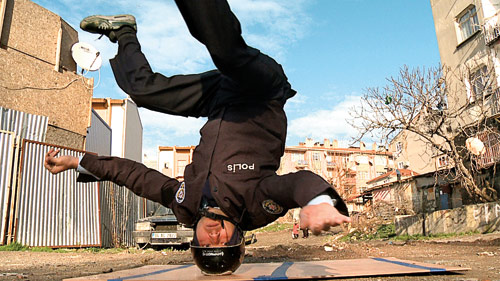2013
Halİl Altindere
Over the past two decades, Halil Altındere’s work has collided time and again with the rapidly changing political and social reality of Turkey. In a project made for the 5th Istanbul Biennial in 1997, he dubbed this troubled relationship to his homeland with Dance with Taboos, which consisted of large-scale reproductions of his identity card were displayed one after the other, the artist’s face becoming increasingly hidden in each photograph. Elsewhere, an identity card depicting the artist with his head in his hands was shown next to a blown-up banknote featuring Turkey’s first president, Kemal Atatürk, apparently mimicking Altındere’s shameful gesture – and thus joining the artist in rejecting a national identity premised upon the annihilation of his own culture and ethnicity as a Kurd.

At the latest Istanbul Biennial in 2013, the game of hide-andseek hinted at in this early work quite literally materialises in the images of Romani teenagers running from the police in Wonderland, a video that can also be seen in this 31st Bienal. Featuring the local hip-hop group Tahribad-ı İsyan, this work adopts the visual language of rap music videos to furiously denounce the destruction of centuries-old Romani settlements in Sulukule, central Istanbul, to make way for high-end developments. If Dance with Taboos put the Kurdish question in the spotlight at a time when the Turkish state was wiping out village after village in the southeast of the country, here Altındere has captured the unrest caused by Istanbul’s rampant gentrification – a feeling of discontent that would gain momentum in the Gezi Park protests of spring 2013.

Bookended by these two bold gestures of political dissent, Altındere’s practice can be seen as an investigation of both forms of government – as sanctioned by the state, the art system or social mores – and vernacular languages of resistance to that very exercise of power. His artistic strategies are rather tongue-in-cheek: always caustic and irreverent, his conceptual irony is exemplified by his adaptation of Emma Goldman’s famous dictum with If I can’t dance it’s not my revolution (2010), which he moulded into a gold necklace in the style of a fashionable trinket, thereby turning a marker of normative identity into a statement of defiance. – HV